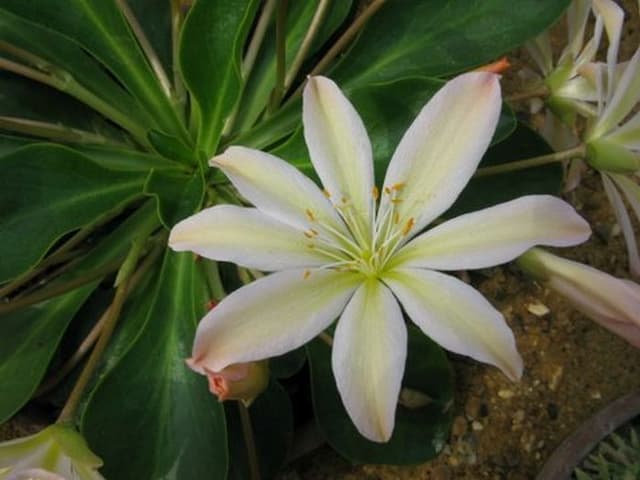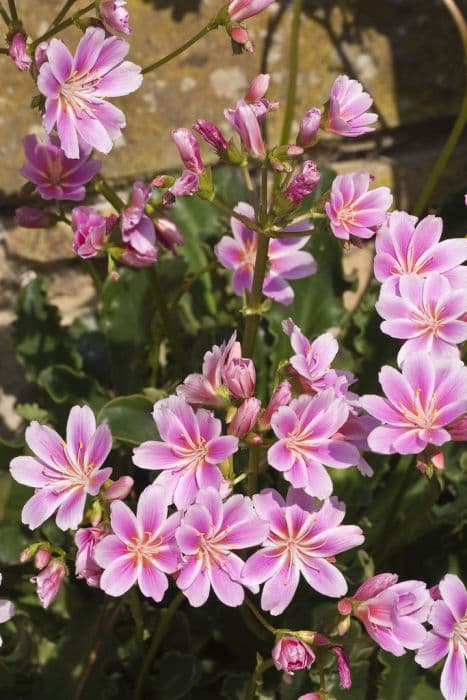Little Raspberry Lewisia Lewisia 'Little Raspberry' (Little Series)

ABOUT
Lewisia 'Little Raspberry' is a charming perennial known for its attractive and vibrant appearance. This plant boasts a lush rosette of succulent, spoon-shaped leaves that have a rich green color. The foliage provides a lovely backdrop for the delightful blooms that emerge on slender stalks. These flowers are the true stars of the plant, with their bright raspberry-pink color, which gives the cultivar its name 'Little Raspberry'. Each bloom consists of multiple, delicate petals arranged in a mesmerizing pattern around a central hub. The flowers tend to have a slightly frilly appearance adding to their charm. Blooming prolifically, the plant creates a colorful display that is sure to catch the eye. The overall impression of Lewisia 'Little Raspberry' is that of a vibrant and cheerful plant that can add a splash of color to any garden without overwhelming it with size.
About this plant
 Names
NamesFamily
Montiaceae
Synonyms
Little Raspberry Bitterroot
Common names
Lewisia 'Little Raspberry'.
 Toxicity
ToxicityTo humans
Little Raspberry is not known to be toxic to humans. However, it is generally recommended to avoid ingesting any plant parts if they are not known to be edible, as individual allergic reactions or gastrointestinal upset can occur.
To pets
Little Raspberry is not listed as toxic to pets such as cats and dogs. Still, it's prudent to prevent pets from eating plants as it could potentially cause mild stomach discomfort or an allergic reaction in some animals.
 Characteristics
CharacteristicsLife cycle
Perennials
Foliage type
Evergreen
Color of leaves
Green
Flower color
Pink
Height
1 foot (30 cm)
Spread
1 foot (30 cm)
Plant type
Herb
Hardiness zones
5
Native area
North America
Benefits
 General Benefits
General Benefits- Attractive Blooms: Produces vibrant, raspberry-pink flowers that add a pop of color to gardens.
- Drought Tolerant: Once established, it can survive with minimal watering, making it ideal for water-wise landscapes.
- Compact Size: Its small stature makes it suitable for rock gardens, containers, and small garden spaces.
- Low Maintenance: Requires little upkeep beyond occasional watering and deadheading of spent flowers.
- Alpine Origins: Adapted to harsh conditions, making it a robust option for challenging garden sites.
- Long Flowering Period: Blooms from late spring to summer, providing extended visual interest.
- Attracts Pollinators: Flowers can attract bees and butterflies, which are beneficial for the health of the garden.
- Cold Hardy: Capable of withstanding cold temperatures, making it suitable for a range of climates.
- Evergreen Foliage: Keeps its leaves throughout the year, ensuring that the garden has color even outside the flowering season.
- Rarity: As a less commonly planted variety, it can give a unique touch to garden collections.
 Medical Properties
Medical PropertiesThis plant is not used for medical purposes.
 Air-purifying Qualities
Air-purifying QualitiesThis plant is not specifically known for air purifying qualities.
 Other Uses
Other Uses- Lewisias, like 'Little Raspberry', can be planted in crevices of walls or walkways, where their roots can benefit from the cool, well-drained conditions offered by the stones or pavers.
- They can be used in fairy gardens due to their small size and attractive, colorful flowers, adding a magical touch to miniature landscapes.
- The plant can work as a natural art subject for garden photographers or painters, particularly with its vibrant blooms offering a splash of color.
- Lewisia 'Little Raspberry' can be potted in shallow containers or alpine troughs, showcasing their beauty in small spaces such as balconies or patios.
- Lewisias can serve as living gifts for special occasions, offering a long-lasting alternative to cut flowers.
- The plant's unique texture and form can enhance sensory gardens, providing a tactile and visual experience for visitors.
- Used in a rock garden, Lewisias contribute color and interest among the stony landscape, thriving in the gritty soil conditions.
- Lewisia 'Little Raspberry' can be incorporated into slope and hill plantings to help with soil erosion, thanks to their deep-rooting habit.
- They can also be interesting additions to bonsai collections, with their succulent-like appearance when grown in smaller, controlled sizes.
- Crafters may use the dried flowers of Lewisias in creating natural, floral decorations such as potpourri or pressed flower art.
Interesting Facts
 Feng Shui
Feng ShuiThe Lewisia is not used in Feng Shui practice.
 Zodiac Sign Compitability
Zodiac Sign CompitabilityThe Lewisia is not used in astrology practice.
 Plant Symbolism
Plant Symbolism- Tenacity: Lewisia, named after explorer Meriwether Lewis, often grows in harsh, rocky environments, symbolizing the ability to thrive amidst difficulties.
- Survival: With its ability to survive in poor soil and with minimal water, Lewisia 'Little Raspberry' represents resilience and adaptability.
- Beauty in Simplicity: The delicate blossoms of 'Little Raspberry' symbolize finding beauty in simple, modest surroundings.
- Femininity: The soft, pinkish hues of the flowers are often associated with gentleness and traditional feminine qualities.
 Water
WaterBitterroot should be watered deeply but infrequently, allowing the soil to dry out between waterings. Generally, watering once every 1 to 2 weeks with about 1 to 2 gallons of water is adequate, adjusting for climate and weather conditions. It's crucial to avoid waterlogging as these plants are susceptible to rot in wet conditions. During the winter months, reduce watering to a minimum as the plant enters a period of dormancy.
 Light
LightBitterroot thrives best in full sun to partial shade. The ideal spot for this plant would be where it receives bright light for at least 6 hours a day. It can tolerate some light shade, especially in the hottest part of the day, but too much shade can reduce blooming and weaken the plant.
 Temperature
TemperatureBitterroot prefers cool to average room temperatures, thriving between 40 to 75 degrees Fahrenheit. It can survive minimum temperatures down to 20 degrees Fahrenheit and maximum temperatures up to 80 degrees Fahrenheit, but prolonged exposure outside this range could harm the plant.
 Pruning
PruningBitterroot should be pruned to remove spent flowers and dead foliage, which encourages further blooming and maintains the plant's appearance. Pruning is best done after the main flowering period has finished. It is usually not necessary to prune more than once per year unless dead or damaged leaves need to be removed.
 Cleaning
CleaningAs needed
 Soil
SoilBitterroot prefers a well-draining soil mix with added grit or sand, ensuring moisture doesn't linger too long. Aim for a slightly acidic to neutral pH, around 6.0 to 7.0, for optimal growth.
 Repotting
RepottingBitterroot should be repotted every 2 to 3 years to refresh the soil and prevent it from becoming compacted, which can inhibit drainage and aeration.
 Humidity & Misting
Humidity & MistingBitterroot thrives in moderate to slightly dry humidity conditions and doesn't require high humidity levels to flourish.
 Suitable locations
Suitable locationsIndoor
Place Bitterroot in bright, indirect light with good air circulation.
Outdoor
Ensure full sun to partial shade; protect Bitterroot from intense afternoon sun.
Hardiness zone
4-8 USDA
 Life cycle
Life cycleLewisia 'Little Raspberry', commonly known as Little Raspberry, begins its life cycle as a seed, often germinating in the cool temperatures of late winter to early spring. Upon germination, it develops a taproot and a rosette of fleshy, evergreen leaves. As the plant matures, typically in its second year, it sends up flowering stalks bearing clusters of small, attractive raspberry-pink flowers in late spring to summer. After pollination, usually by bees or other insects, the plant sets seed within capsule-like fruits that ripen and release seeds to propagate the next generation. In the winter months, the plant may go dormant above ground, but the taproot survives to regenerate foliage in the spring. This perennial may live for several years, going through cycles of growth, flowering, seed production, and dormancy annually.
 Propogation
PropogationPropogation time
Spring-Summer
For Lewisia 'Little Raspberry', a common method of propagation is by division, typically done in spring or fall. This involves gently separating the crowns at the root when the plant has become large and clumped. First, you must carefully dig around the plant to lift it from the soil without damaging the roots. Using a sharp and clean knife, divide the crown into sections, ensuring that each section has at least one growth point or bud. After division, the plant sections can be replanted at the same soil level they were grown before, spaced about 6 to 12 inches apart (15 to 30 centimeters) to allow for ample growth. Water them well after planting to help establish the new divisions. This method allows the gardener to produce new plants that will mature and flower quicker than those from seeds.




